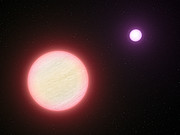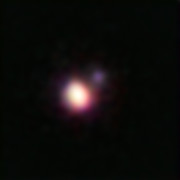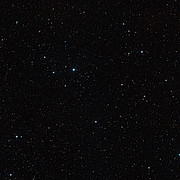Press Release
A Very Cool Pair of Brown Dwarfs
23 March 2011
Observations with the European Southern Observatory’s Very Large Telescope, along with two other telescopes, have shown that there is a new candidate for the coldest known star: a brown dwarf in a double system with about the same temperature as a freshly made cup of tea — hot in human terms, but extraordinarily cold for the surface of a star. This object is cool enough to begin crossing the blurred line dividing small cold stars from big hot planets.
Brown dwarfs are essentially failed stars: they lack enough mass for gravity to trigger the nuclear reactions that make stars shine. The newly discovered brown dwarf, identified as CFBDSIR 1458+10B, is the dimmer member of a binary brown dwarf system located just 75 light-years from Earth [1].
The powerful X-shooter spectrograph on ESO’s Very Large Telescope (VLT) was used to show that the composite object was very cool by brown dwarf standards. "We were very excited to see that this object had such a low temperature, but we couldn’t have guessed that it would turn out to be a double system and have an even more interesting, even colder component," said Philippe Delorme of the Institut de planétologie et d’astrophysique de Grenoble (CNRS/Université Joseph Fourier), a co-author of the paper. CFBDSIR 1458+10 is the coolest brown dwarf binary found to date.
The dimmer of the two dwarfs has now been found to have a temperature of about 100 degrees Celsius — the boiling point of water, and not much different from the temperature inside a sauna [2]. “At such temperatures we expect the brown dwarf to have properties that are different from previously known brown dwarfs and much closer to those of giant exoplanets — it could even have water clouds in its atmosphere," said Michael Liu of the University of Hawaii’s Institute for Astronomy, who is lead author of the paper describing this new work. "In fact, once we start taking images of gas-giant planets around Sun-like stars in the near future, I expect that many of them will look like CFBDSIR 1458+10B."
Unravelling the secrets of this unique object involved exploiting the power of three different telescopes. CFBDSIR 1458+10 was first found to be a binary using the Laser Guide Star (LGS) Adaptive Optics system on the Keck II Telescope in Hawaii [3]. Liu and his colleagues then employed the Canada–France–Hawaii Telescope, also in Hawaii, to determine the distance to the brown dwarf duo using an infrared camera [4]. Finally the ESO VLT was used to study the object’s infrared spectrum and measure its temperature.
The hunt for cool objects is a very active astronomical hot topic. The Spitzer Space Telescope has recently identified two other very faint objects as other possible contenders for the coolest known brown dwarfs, although their temperatures have not been measured so precisely. Future observations will better determine how these objects compare to CFBDSIR 1458+10B. Liu and his colleagues are planning to observe CFBDSIR 1458+10B again to better determine its properties and to begin mapping the binary's orbit, which, after about a decade of monitoring, should allow astronomers to determine the binary’s mass.
Notes
[1] CFBDSIR 1458+10 is the name of the binary system. The two components are known as CFBDSIR 1458+10A and CFBDSIR 1458+10B, with the latter the fainter and cooler of the two. They seem to be orbiting each other at a separation of about three times the distance between the Earth and the Sun in a period of about thirty years.
[2] By comparison the temperature of the surface of the Sun is about 5500 degrees Celsius.
[3] Adaptive optics cancels out much of Earth’s atmospheric interference, improving the image sharpness by a factor of ten and enabling the very small separation binary to be resolved.
[4] The astronomers measured the apparent motion of the brown dwarfs against the background of more distant stars caused by Earth's changing position in its orbit around the Sun. The effect, known as parallax, allowed them to determine the distance to the brown dwarfs.
More information
This research was presented in a paper, “CFBDSIR J1458+1013B: A Very Cold (>T10) Brown Dwarf in a Binary System”, Liu et al. to appear in the Astrophysical Journal.
The team is composed of Michael C. Liu (Institute for Astronomy [IfA], University of Hawaii, USA), Philippe Delorme (Institut de planétologie et d’astrophysique de Grenoble, CNRS/Université Joseph Fourier, France [IPAG]), Trent J. Dupuy (Harvard-Smithsonian Center for Astrophysics, Cambridge, USA), Brendan P. Bowler (IfA), Loic Albert (Canada-France-Hawaii Telescope Corporation, Hawaii, USA), Etienne Artigau (Université de Montréal, Canada), Celine Reylé (Observatoire de Besançon, France), Thierry Forveille (IPAG) and Xavier Delfosse (IPAG).
ESO, the European Southern Observatory, is the foremost intergovernmental astronomy organisation in Europe and the world’s most productive astronomical observatory. It is supported by 15 countries: Austria, Belgium, Brazil, Czechia, Denmark, France, Finland, Germany, Italy, the Netherlands, Portugal, Spain, Sweden, Switzerland and the United Kingdom. ESO carries out an ambitious programme focused on the design, construction and operation of powerful ground-based observing facilities enabling astronomers to make important scientific discoveries. ESO also plays a leading role in promoting and organising cooperation in astronomical research. ESO operates three unique world-class observing sites in Chile: La Silla, Paranal and Chajnantor. At Paranal, ESO operates the Very Large Telescope, the world’s most advanced visible-light astronomical observatory and VISTA, the world’s largest survey telescope. ESO is the European partner of a revolutionary astronomical telescope ALMA, the largest astronomical project in existence. ESO is currently planning a 42-metre European Extremely Large optical/near-infrared Telescope, the E-ELT, which will become “the world’s biggest eye on the sky”.
Links
Contacts
Michael Liu
Institute for Astronomy, University of Hawaii
USA
Tel: +1 808 956 6666
Email: mliu@ifa.hawaii.edu
Philippe Delorme
Institut de planétologie et d’astrophysique de Grenoble
France
Tel: +33 4 76 63 58 30
Email: Philippe.Delorme@obs.ujf-grenoble.fr
Christian Veillet
Executive Director, CFHT, Hawaii
USA
Tel: +1 808 885 7944
Email: veillet@cfht.hawaii.edu
Richard Hook
ESO, La Silla, Paranal, E-ELT and Survey Telescopes Press Officer
Garching bei München, Germany
Tel: +49 89 3200 6655
Email: rhook@eso.org
About the Release
| Release No.: | eso1110 |
| Name: | CFBDSIR 1458+10 |
| Type: | Milky Way : Star : Type : Brown Dwarf |
| Facility: | CFHT, New Technology Telescope, Very Large Telescope, W. M. Keck Observatory |
| Instruments: | SOFI, X-shooter |
| Science data: | 2011ApJ...740..108L |
Our use of Cookies
We use cookies that are essential for accessing our websites and using our services. We also use cookies to analyse, measure and improve our websites’ performance, to enable content sharing via social media and to display media content hosted on third-party platforms.
ESO Cookies Policy
The European Organisation for Astronomical Research in the Southern Hemisphere (ESO) is the pre-eminent intergovernmental science and technology organisation in astronomy. It carries out an ambitious programme focused on the design, construction and operation of powerful ground-based observing facilities for astronomy.
This Cookies Policy is intended to provide clarity by outlining the cookies used on the ESO public websites, their functions, the options you have for controlling them, and the ways you can contact us for additional details.
What are cookies?
Cookies are small pieces of data stored on your device by websites you visit. They serve various purposes, such as remembering login credentials and preferences and enhance your browsing experience.
Categories of cookies we use
Essential cookies (always active): These cookies are strictly necessary for the proper functioning of our website. Without these cookies, the website cannot operate correctly, and certain services, such as logging in or accessing secure areas, may not be available; because they are essential for the website’s operation, they cannot be disabled.
Functional Cookies: These cookies enhance your browsing experience by enabling additional features and personalization, such as remembering your preferences and settings. While not strictly necessary for the website to function, they improve usability and convenience; these cookies are only placed if you provide your consent.
Analytics cookies: These cookies collect information about how visitors interact with our website, such as which pages are visited most often and how users navigate the site. This data helps us improve website performance, optimize content, and enhance the user experience; these cookies are only placed if you provide your consent. We use the following analytics cookies.
Matomo Cookies:
This website uses Matomo (formerly Piwik), an open source software which enables the statistical analysis of website visits. Matomo uses cookies (text files) which are saved on your computer and which allow us to analyze how you use our website. The website user information generated by the cookies will only be saved on the servers of our IT Department. We use this information to analyze www.eso.org visits and to prepare reports on website activities. These data will not be disclosed to third parties.
On behalf of ESO, Matomo will use this information for the purpose of evaluating your use of the website, compiling reports on website activity and providing other services relating to website activity and internet usage.
Matomo cookies settings:
Additional Third-party cookies on ESO websites: some of our pages display content from external providers, e.g. YouTube.
Such third-party services are outside of ESO control and may, at any time, change their terms of service, use of cookies, etc.
YouTube: Some videos on the ESO website are embedded from ESO’s official YouTube channel. We have enabled YouTube’s privacy-enhanced mode, meaning that no cookies are set unless the user actively clicks on the video to play it. Additionally, in this mode, YouTube does not store any personally identifiable cookie data for embedded video playbacks. For more details, please refer to YouTube’s embedding videos information page.
Cookies can also be classified based on the following elements.
Regarding the domain, there are:
- First-party cookies, set by the website you are currently visiting. They are stored by the same domain that you are browsing and are used to enhance your experience on that site;
- Third-party cookies, set by a domain other than the one you are currently visiting.
As for their duration, cookies can be:
- Browser-session cookies, which are deleted when the user closes the browser;
- Stored cookies, which stay on the user's device for a predetermined period of time.
How to manage cookies
Cookie settings: You can modify your cookie choices for the ESO webpages at any time by clicking on the link Cookie settings at the bottom of any page.
In your browser: If you wish to delete cookies or instruct your browser to delete or block cookies by default, please visit the help pages of your browser:
Please be aware that if you delete or decline cookies, certain functionalities of our website may be not be available and your browsing experience may be affected.
You can set most browsers to prevent any cookies being placed on your device, but you may then have to manually adjust some preferences every time you visit a site/page. And some services and functionalities may not work properly at all (e.g. profile logging-in, shop check out).
Updates to the ESO Cookies Policy
The ESO Cookies Policy may be subject to future updates, which will be made available on this page.
Additional information
For any queries related to cookies, please contact: pdprATesoDOTorg.
As ESO public webpages are managed by our Department of Communication, your questions will be dealt with the support of the said Department.




